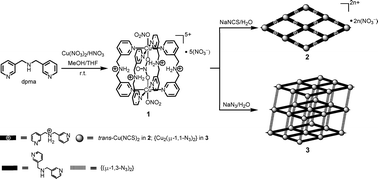A novel M2L4 tetragonal metalloprism, [(NO3−)⊂{Cu2(μ-Hdpma)4}(NO3)2](NO3)5 (1), was prepared from the self-assembly reaction of Cu(NO3)2·3H2O and flexible clip-like organic ligand di(3-pyridylmethyl)amine (dpma) under acidic conditions. The cationic prismatic hollow structure of 1hosts one nitrate anion via both metal–ligand dative bonds and electrostatic interactions. Metalloprism 1 can dissolve in water and its prismatic structure remains intact as supported by ESI-MS data. When metalloprism 1 was treated with sodium thiocyanate and sodium azide in aqueous solutions, two polymeric coordination architectures, [Cu(μ-Hdpma)2(NCS)2](NO3)2 (2) and [Cu(μ-dpma)2(μ-1,1-N3)(μ-1,3-N3)] (3), formed at room temperature, respectively. Polymer 2 has a two-dimensional sheet structure showing a simple rhombic 44-sql topology in network connectivity, whereas polymer 3 gives a three-dimensional uninodal pcu net. The conformation of the flexible ditopic ligand is varied from a trans-trans-syn conformer in 1 to a trans-trans-anti conformer in 2 and to a trans-gauche-anti conformer in 3. The observations imply the occurrence of structural transformation from a discrete metalloprism into polymeric coordination architectures via a decoordination/rearrangement process. Magnetic studies of metalloprism 1 suggest that the two Cu(II) centers are weakly antiferromagnetically coupled. The spins communicate via the nitrate template while the Cu⋯O(nitrate) interactions are weak. For polymer 3, a ferromagnetically coupled system (J2 = +17.6 cm−1) is operative between two Cu(II) centers bridged by end-on azidos and an antiferromagnetic coupling (J1 = −7.7 cm−1) between two Cu(II) centers with end-to-end azidos. In contrast to relatively large coupling values of the reported examples, the weak ferromagnetic interaction results from insufficient spin delocalization between two Cu(II) centers.

